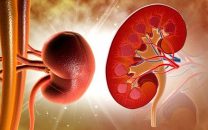Pulmonary hypertension (PH) in patients with severe aortic stenosis undergoing transcatheter aortic valve replacement (TAVR) should not preclude this procedure. In fact, TAVR will resolve this condition in most cases. More than three quarters of patients undergoing TAVR have some level of PH, though this has not been associated to increased mortality, according to this…
Liver Failure as a Challenge for TAVR
Although surgical risk scores do not include liver failure (LF), patients who suffer from it and undergo cardiovascular surgery present high rates of morbidity and mortality. This is due to alteration of cardiac function, increased infection susceptibility, gastrointestinal complications, and increased bleeding. As regards transcatheter aortic valve replacement (TAVR), these patients have not been included…
TAVR with Prior MRS: A New Challenge
The benefits of transcatheter aortic valve replacement (TAVR) for high-risk, prohibitive-risk (class I) or intermediate-risk (class IIa) patients have already been proven, but there is a growing population of patients with a history of myocardial revascularization surgery (MRS) who experience severe aortic stenosis. Decision-making in these cases is anything but simple, mainly due to the presence of…
Bicuspid Valves Do Not Increase Mortality in TAVR
The frequency of bicuspid aortic valves (BcAV) are around 1%, but in 60+ patients it is associated to severe aortic stenosis. Even though surgery is the standard treatment, TAVR is the “off label” indication in high risk patients. BcAV presents differences with tricuspids given that it is more elliptic, has asymmetric calcification and more…
Significant Association Between Suprarenal Fixation of Endoprostheses and Renal Dysfunction
According to this meta-analysis, soon to be published in Eur. J. Vasc. Endovasc. Surg., endovascular abdominal aortic aneurysm repair prostheses with suprarenal fixation do not alter significantly the glomerular filtration rate at one year from device implantation. However, we should acknowledge that long-term outcomes are still unknown. The literature is inconsistent as regards the definition…
Constrictive Pericarditis After Pericardiocentesis
All interventional cardiologists must be able to perform a pericardiocentesis. Whether we deal with a chronic total occlusion, a supposedly simple coronary angioplasty (we all have witnessed the perforation of a supposedly risk-free coronary artery), or a transcatheter aortic valve replacement (whose rise gave us another significant source of tamponades), we must all be ready…
Stroke, Migraine and Patent Foramen Ovale Not Necessarily Temporary Associated
Cryptogenic stroke patients with migraine have high prevalence (79%) of patent foramen ovale (PFO) with right to left shunt. However, the timing of stroke in migraineurs is not usually associated to a migraine attack. These observations are consistent with the hypothesis that the most likely mechanism of stroke in these patients with migraine is a…
We Should Consider Mitral Stenosis Before TAVR
The association between aortic stenosis and some degree of mitral stenosis (MS) is around 10% (depending on the series), and it is related with negative outcomes. In high-risk and inoperable patients who underwent TAVR, that association and its significance have not been studied yet. The study analyzed data from the Society of Thoracic Surgeons/American…
Morbidity and Mortality During Authorization Wait-Times for TAVR
For this Canada-based study, the increased number of patients who required a transcatheter aortic valve replacement (TAVR) may have come hand in hand with an equal increase in healthcare financing, so as to cover procedural costs. In spite of that, the wait-time between the formal request for authorization and the actual procedure was 3 months, and…
Do the Best Coronary Revascularization Prior TAVR
The presence of coronary artery disease (CAD) in patients with aortic stenosis is high, reaching 50% to70% of cases. This poses a great challenge as to what strategy to use and the things we can do. Even though it has been shown complete revascularization is beneficial, it is often difficult to achieve. Instead, reasonable incomplete…









